The Samsung Galaxy Tab S2 Review
by Brandon Chester on October 15, 2015 8:00 AM ESTDisplay Analysis
Before getting into our typical display analysis, I wanted to address a question that I'm sure some people have. A quick examination of a Tab S2 8.0's subpixel arrangement confirms that the smaller model uses a PenTile subpixel arrangement, and there's significant artifacting on the edges of icons and text, with the issue being very pronounced with thin weighted fonts. This is a big disappointment for users who prefer small tablets, and I would almost hesitate to recommend the smaller model for that reason alone because of how prevalent the issue is.
While the smaller model of the Tab S2 uses diamond PenTile, the Tab S2 9.7" does use an RGB-like subpixel arrangement, and it's essentially the same as the one used on the original Tab S 10.5. In practice there aren't really any artifacts as a result of the subpixels not being lined up exactly like a conventional LCD display, and it looks every bit as sharp as the iPad Air 2 which is exactly what I had hoped for.
To test the various attributes of the Tab S2 9.7's display I've run it through out standard display workflow. All measurements are done with an X-Rite i1Pro 2 spectrophotometer, and in the case of LCD devices the contrast measurements are done with an i1Display Pro colorimeter. SpectraCal's CalMAN 5 software is used for measuring and collecting data, and for generating graphs that are relatively easy to understand.
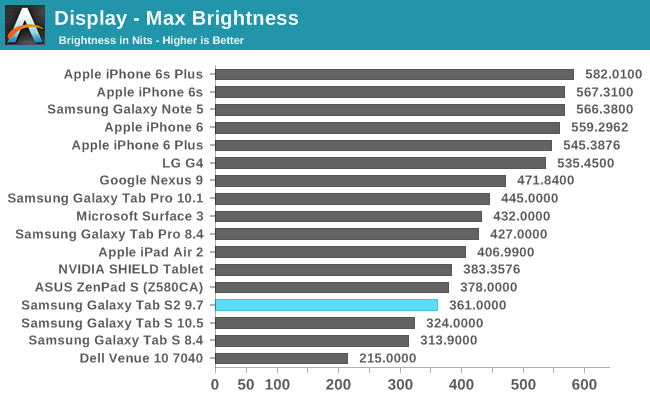
The Average Picture Level (APL) of an image can be thought of as a percentage expressing the luminance relative to a 100% white display. Since AMOLED displays target a given power consumption but can save power by turning off black pixels they can push a higher maximum brightness when the display's APL is low. Above you can see how the maximum brightness of white scales with average picture level. Real world use cases tend to be somewhere around 80% APL, and while there are always exceptions, this trend has continued with Google's new guidelines for designing Material Design applications. What's important about this chart is it shows that in most scenarios the Tab S2 9.7 actually isn't any dimmer than a tablet like the iPad Air 2, and much brighter than the original Tab S.
As for contrast, there's no point in displaying a chart, as Samsung's AMOLED displays can simply shut off pixels and achieve infinite contrast and true blacks. There's really nothing that comes close on any LCD-based tablet, and the true blacks of AMOLED displays simply become even more stunning as you scale up from a phone to a tablet, and again from a tablet to a television.
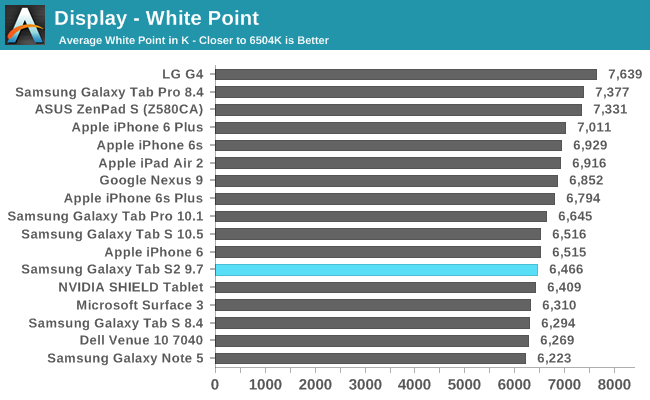
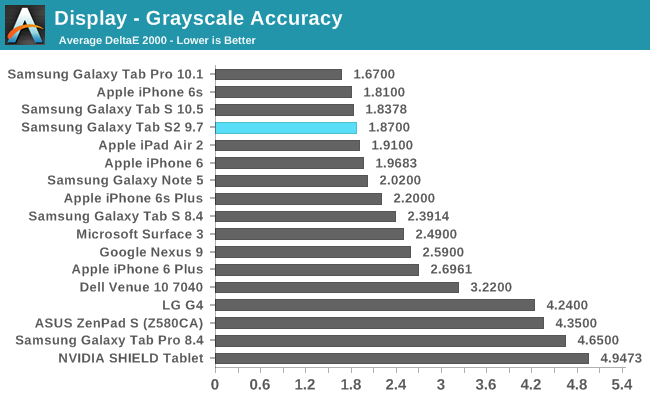
Samsung's AMOLED calibration has improved tremedously in recent years, and the Tab S2 9.7 is no exception. The greyscale has a very high level of accuracy, with very low errors across the board. When you move past 70% white there is a degree of green tinting to whites and greys that appears, and this is noticeable during general use. I did find it to be somewhat bothersome, but I think this is mostly due to the fact that I test and use many different devices regularly. If the Tab S2 9.7 was my only tablet I would be perfectly happy with the level of calibration, and I would get used to the good but not perfect calibration when shades approach 100% white.
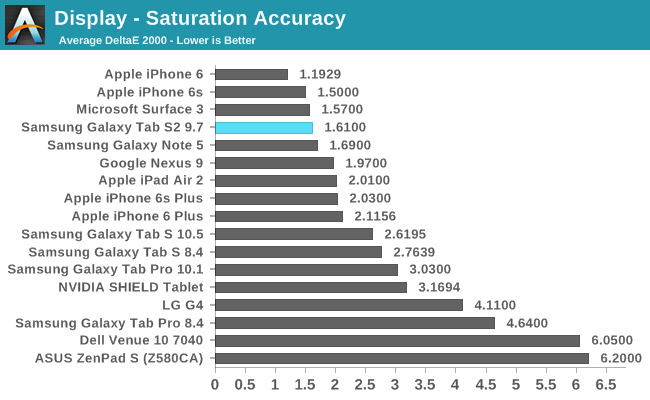
Saturation accuracy on the Tab S2 9.7 is phenomenal. It's better than every other tablet except for the Microsoft Surface 3, and at this point you would really be hard pressed to see errors in the rendering of pure primary and secondary colors. Most of the errors seem to be at the very extreme 100% saturations, and in daily use I never felt like the appearance of colors was off in any way.
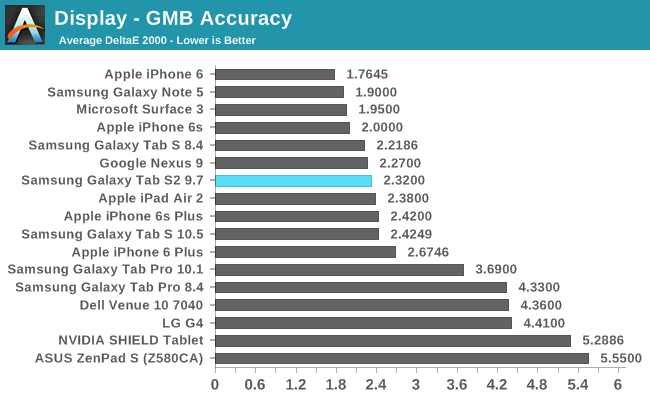
In the Gretag-Macbeth ColorChecker test we again see a very high level of color accuracy on the Tab S2 9.7. The biggest contribution to errors are actually the grey shades that are tested, along with some slight errors in red and blue based color mixtures. To criticize these results would honestly be pedantry, as unless your tablet workflow involves editing videos and photos with absolutely no visible color errors the Tab S2 9.7 provides a more than sufficient level of accuracy.
There's really not much else to say about the Tab S2 9.7's display. Samsung has really done a great job with calibrating the displays on recent AMOLED devices, and the Tab S2 9.7 offers a display that is just as good as any other tablet. One could argue that the true blacks actually put the Tab S2 9.7 ahead of the competition, and I would be inclined to agree. My only complaint is that the iPad Air 2 with its AR coating tends to be a bit more usable outside and in other scenarios where there are heavy reflections. There's really no way to conclude which tablet offers the absolute best display, but I think it would be correct to say that in most cases the Tab S2 9.7's display is as good, if not better than any other tablet on the market.


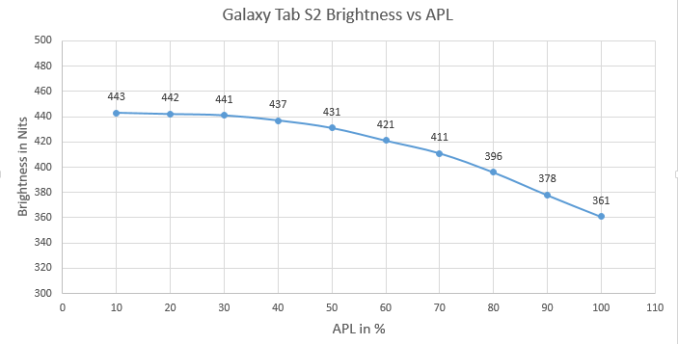
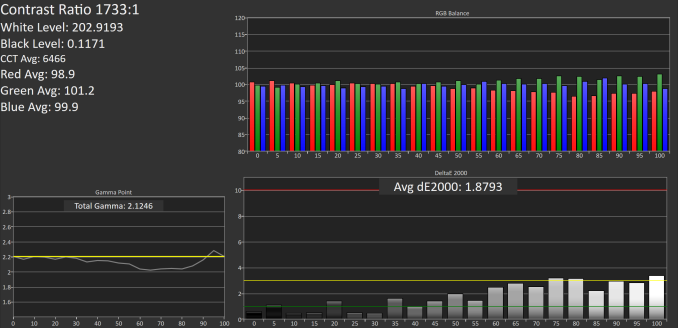

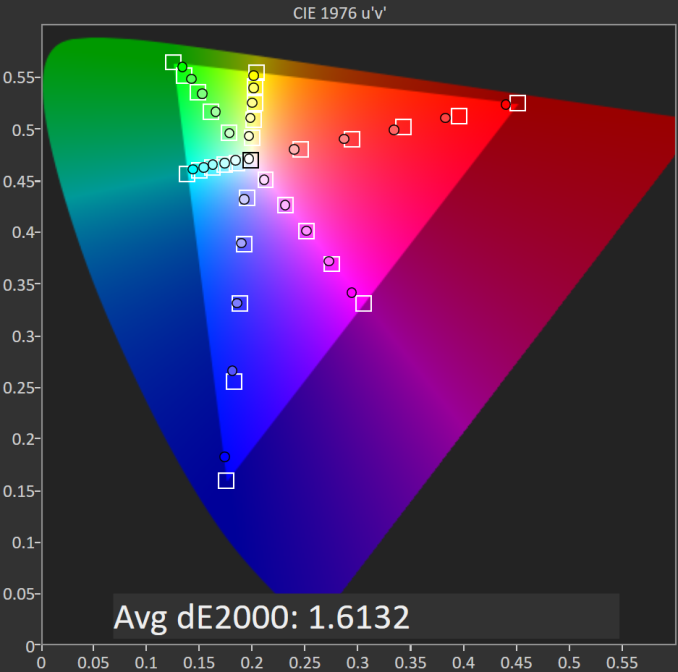










162 Comments
View All Comments
osxandwindows - Thursday, October 15, 2015 - link
@FlyBriWhat if you could get an iPad screen on an iPhone?
lilmoe - Thursday, October 15, 2015 - link
You have all the right to disagree. These are only opinions, Yours and mine. These opinions might be very different from Samsung's research and design decisions. I've simply stated a *possibility* for their alleged "compromise(s)". Who knows, Samsung probably decided to skip the 7420 because of low yield, and they prioritized their flagship smartphones over their tablets.That said, liking the iPad's LCD has nothing to do with the price difference. AMOLED is still more expensive to manufacture. I would argue that OLED is generally more appealing to consumers and more pleasing to the eyes. Samsung's AMOLED has drastically improved the past couple of years. According to my own experience, people just love the "pop"... And those who prefer color accuracy are also well served by the current generation of AMOLED.
ARM tablets are no longer the mainstream "must haves". Most people don't even use them anymore. Samsung, Apple and other manufacturers are researching the needs for specific niche consumers at this point.
For those who do, I really hardly see anyone using an ARM tablet outside of social media, browsing, watching video. Maybe a magazine here and there, but nothing else. I completely disagree that tablet users who play high-end games are any sort of majority. High end, or AAA, gaming is usually exclusive for consoles and PCs. Most tablet users play less resource intensive, casual games. Besides, there aren't even that many titles (if any) in the Play Store than can saturate the Exynos 5433, let alone Apple's A8X (most tablets sold are NOT iPad Air 2s... and game developers target lower specs for iOS). The Exynos 5433 is more than capable of running titles like Asphalt 8 and Dead Trigger just fine.
Also, tablets are used a LOT less than smartphones. Therefore, one might argue that longer battery life isn't as important as thinner, lighter profiles for current tablet consumers.
nerd1 - Thursday, October 15, 2015 - link
Check BOM of iPhones and galaxy phones. AMOLED screen are usually 3x the price of LCDs.And what can you do with that 'powerful' AP anyway? Running dumbed down mobile browser? Running crappy phone games? Playing 8K video on 2K screen?
zepi - Thursday, October 15, 2015 - link
Tablets are an odd market. People mostly seem to use them for web browsing and video viewing, where performance doesn't really matter that much. Reason is unknown. Maybe it is the matter of apps not existing for other tasks. Or maybe tablet form factor just doesn't work with anything else.I guess that mostly because of this, Android makers try to get away with putting cheap and "slow" SOC's into their tablets.
Apple hit the same issue when it was noticed that iPad sales was way slower than expected. It seems that upgrade cycles are much longer, since simple performance bumps just didn't seem to matter and there are no 24month phone-contracts like with the phones to push sales. This has obviously led to Apple's current push towards trying to transform tablet market by making iPad Air 2 & iPad Pro and putting emphasis behind the productivity use with the hopes of pushing the market towards something more than just content consumption.
MS seems to be pushing for the same thing with Surfaces, though they are coming from the desktop direction when Apple is approaching this market from mobile device direction.
Android makers... Well, as can be seen here, Samsung can only do so much with the multitasking and productivity features and Google has been quite ignorant towards pushing tablets forwards.
FlyBri - Thursday, October 15, 2015 - link
@zepi I would agree that most people use tablets for web browsing and video (probably more so for web browsing), which is why Samsung went with a 4:3 aspect ratio on the Tab S2. Since they did that, they lost their differentiating factor with the iPad. Because of this, they really needed to step it up to compete, and they pretty much failed on that front. The Tab S2 is significantly slower and gets much worse web browsing battery life than the Air 2, and the Air 2 is a year old. I have no problem with Samsung releasing the Tab S2, but it's very clear it's overpriced. For what it is and what it can do, it's a $300-350 tablet in today's market, not $500.osxandwindows - Thursday, October 15, 2015 - link
You can't really use surface touch screen for productivity, There is simply no windows productivity apps for tablet.The iPad pro is not going to fail like most people say.
The iPad pro has one advantage over the surface and that is the App Store.
zepi - Thursday, October 15, 2015 - link
It remains to be seen. Personally my guess is that both will have their supporters and both will "stay alive".osxandwindows - Thursday, October 15, 2015 - link
@zepiIts not that I don't like the concept behind the surface pro or surface book.
Its just that I don't see the use of a touch screen that can be removed.
Media consumption?, with 3 hours of battery life when removed?, I wood rather buy an iPad for that.
blackcrayon - Thursday, October 15, 2015 - link
Yeah at that point, why not have a nice laptop and a decent tablet on the side, you can even use them together for some tasks.osxandwindows - Thursday, October 15, 2015 - link
If you have a mac and an iPad pro, You will have the perfect combination.Apples continuity is pretty much like a surface use case.
Plus with lightning flash drives you will be able to save 4k video.